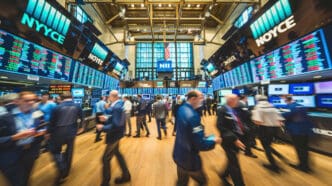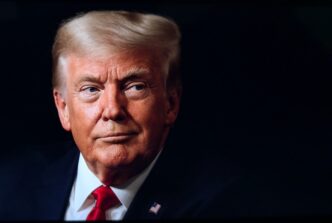NEW YORK – U.S. stocks swung from modest gains to sharp losses and back again on Wednesday after President Donald Trump confirmed he had “talked about the concept of firing” Federal Reserve Chair Jerome Powell, a move that would shatter the long-standing independence of the nation’s central bank.
The president’s comments sent a tremor through Wall Street, highlighting the market’s deep anxiety over a potential clash between the White House and the Federal Reserve. While the prospect of a new, more politically pliable Fed chair could lead to the lower interest rates that investors crave, it also raises the specter of a weakened institution unable to make the unpopular decisions necessary to keep inflation under control.
The S&P 500 was trading down 0.1% in the midday session, but only after a volatile morning. The index had been rising modestly following a better-than-expected report on wholesale inflation, but it quickly dropped as much as 0.7% on midmorning news reports that Trump was likely to fire Powell. When later asked directly about his plans, Trump told reporters, “I don’t rule out anything, but I think it’s highly unlikely, unless he has to leave for fraud.”
The Dow Jones Industrial Average was up just 4 points, or less than 0.1%, as of 12:15 p.m. Eastern time, while the Nasdaq composite was down 0.1% from the record high it set a day earlier.
The market turbulence underscores the high-stakes battle over interest rate policy. President Trump has been openly furious with Powell for not cutting interest rates this year, a move that would stimulate the economy by making it cheaper for households and businesses to borrow money. Lower rates could also provide a significant boost to the U.S. government, which is set to borrow heavily to finance a wide range of tax cuts.
However, Chair Powell has consistently maintained a more cautious stance, insisting that the Fed needs more data on how the president’s tariffs will affect the economy and inflation before making its next move. The central bank’s primary mandate is to maintain price stability, and after the post-pandemic shock that sent inflation soaring above 9%, the Fed is wary of reigniting inflationary pressures.
Wednesday’s economic data painted a conflicting picture for the Fed. A report on wholesale prices showed that inflation slowed more than economists expected last month, down to 2.3%, an encouraging sign. But just a day earlier, another report suggested that Trump’s tariffs are indeed pushing up the prices U.S. shoppers are paying for imported goods like toys and apparel.
The weight of the administration’s tariff policies is being felt across global markets. ASML, the world’s leading supplier of equipment for chipmakers, warned that it cannot guarantee any growth next year after forecasting 15% growth for 2025. “The level of uncertainty is increasing, mostly due to macroeconomic and geopolitical consideration. And that includes, of course, tariffs,” CEO Christophe Fouquet said in a video statement. U.S.-traded shares of the Netherlands-based company fell 9.1%.
Offsetting some of the broader market weakness were strong earnings reports from several U.S. companies. Johnson & Johnson jumped 6.5% after the healthcare giant beat analysts’ sales and profit targets and raised its full-year forecasts. PNC Financial Services Group added 0.4% after its own better-than-expected quarterly report.
In other market news, GrabAGun, an online firearms retailer, saw extreme volatility in its first day of trading under the ticker “PEW” after merging with a special purpose acquisition company. The company, which is adding Donald Trump Jr. to its board, saw its stock swing from an early gain of 19% to a drop of 31% before moderating.
In the bond market, the yield on the 10-year U.S. Treasury fell to 4.47%. The yield had been lower earlier in the day but erased some of its losses following the reports about Powell. While a new, Trump-friendly Fed chair might cut short-term rates more quickly, the threat to the Fed’s independence raises concerns that it may also allow inflation to run higher in the future, a scenario that can push up yields on longer-term bonds.








